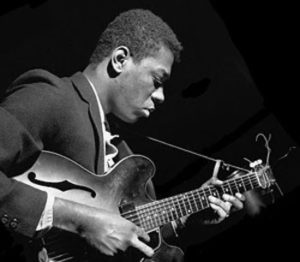
Grant Green
*Grant Green was born on this date in 1935. He was a Black jazz guitarist and composer.
Grant Green was born to John and Martha Green in St. Louis, Missouri. His father was a laborer and a Saint Louis policeman at various times. Green first performed in a professional setting at the age of 13 as a member of a gospel music ensemble. His influences were Charlie Christian, Charlie Parker, Lester Young, and Jimmy Raney. He first played boogie-woogie before moving on to jazz.
His first recordings in St. Louis were with tenor saxophonist Jimmy Forrest for the United label, where Green played alongside drummer Elvin Jones. Green recorded with Jones for several albums in the mid-1960s. In 1959, Lou Donaldson discovered Green playing in a bar in St. Louis and hired him for his touring band. Green moved to New York at some point during 1959–60. Lou Donaldson introduced Green to Alfred Lion of Blue Note Records. Lion was so impressed that, rather than first using Green as a sideman, as was the usual Blue Note practice, Lion arranged for him to record initially as a group leader. However, due to Green's lack of confidence, the initial recording session was only released in 2001 as First Session. Green's recording relationship with Blue Note was to last throughout the 1960s. His first issued album as a leader was Grant's First Stand. This was followed in the same year by Green Street and Grandstand.
Green was named best new star in the Down Beat critics' poll in 1962. He often supported the other musicians on Blue Note, including saxophonists Hank Mobley, Ike Quebec, Stanley Turrentine, and organist Larry Young. Sunday Mornin’, The Latin Bit, and Feelin' the Spirit are all loose concept albums, each taking a musical theme or style: gospel, Latin, and spirituals, respectively. Grant consistently delivered his more commercial dates with artistic success during this period. Idle Moments (1963), featuring Joe Henderson and Bobby Hutcherson, and Solid (1964) are described by professional jazz critics as two of Green's best recordings.
Many of Green's recordings were not released during his lifetime. These include several albums with pianist Sonny Clark, recorded in 1961-1962, and two from 1964 (Matador and Solid), which featured McCoy Tyner and Elvin Jones from the John Coltrane Quartet. 1966 Green left Blue Note and recorded for several other labels, including Verve. From 1967 to 1969, Green was inactive primarily due to personal problems and the effects of heroin addiction. In 1969, Green returned with a new funk-influenced band. His recordings from this period include the commercially successful Green Is Beautiful and the soundtrack to the film The Final Comedown.
Music equipment
Green used a Gibson ES-330, then a Gibson L7 with a Gibson McCarty pickguard/pickup, an Epiphone Emperor (with the same pickup), and finally, a custom-built D'Aquisto. George Benson said Grant achieved his tone by turning off the bass and treble settings and maximizing the midrange. This way, he could get his signature punchy, biting tone. Critics Michael Erlewine and Ron Wynn write, "A severely underrated player during his lifetime, Grant Green is one of the great unsung heroes of jazz guitar. Green's playing is immediately recognizable – perhaps more than any other guitarist." Critic Dave Hunter described his sound as "lithe, loose, slightly bluesy, and righteously groovy." He often performed in an organ trio, a small group with an organ and a drummer.
Therefore, Green's primary approach was almost exclusively linear rather than chordal. He thus rarely played rhythm guitar except as a sideman on albums led by other musicians. The simplicity and immediacy of Green's playing, which tended to avoid chromaticism, derived from his early work playing rhythm and blues. Although he achieved a synthesis of this style with bop, he was a skilled blues and funk guitarist. He returned to this style in his later career.
Green left Blue Note again in 1974, and his subsequent recordings with other labels divided opinion. Green spent much of 1978 in the hospital and, against doctors' advice, went back on the road to earn money. While in New York to play an engagement at George Benson's Breezin' Lounge, he collapsed in his car from a heart attack and died on January 31, 1979. He was buried in Greenwood Cemetery in his hometown of St. Louis, Missouri, and was survived by six children. Since Green's death, his reputation has grown, and numerous compilations have been released.